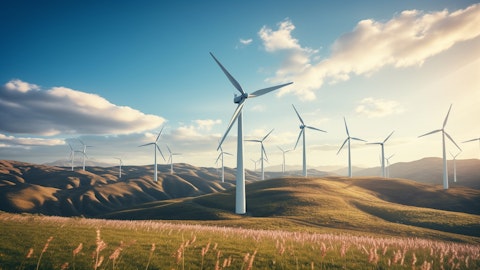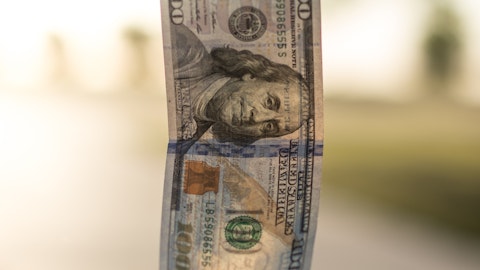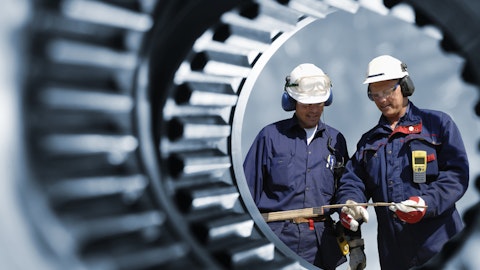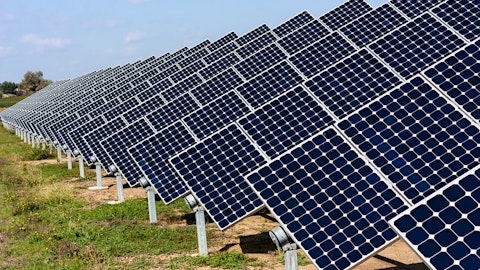Atlantica Sustainable Infrastructure plc (NASDAQ:AY) Q3 2023 Earnings Call Transcript November 8, 2023
Atlantica Sustainable Infrastructure plc misses on earnings expectations. Reported EPS is $0.18 EPS, expectations were $0.26.
Operator: Hello and welcome to Atlantica’s Third Quarter 2023 Financial Results Conference Call. Just a reminder that this call is being webcast live on the internet, and a replay of this call will be available on Atlantica’s corporate website. Atlantica will be making forward-looking statements during this call, which are based on current expectations and assumptions, and are subject to risks and uncertainties. Actual results could differ materially from our forward-looking statements. If any of our peer assumptions are incorrect or because of other factors, including the risk factors section of the accompanying presentation, and in our latest reports and filings with the Securities and Exchange Commission, all of which can be found on our website.
Atlantica does not undertake any duty to update any forward-looking statements. Joining us to today’s conference call are Atlantica’s CEO, Santiago Seage, and CFO, Francisco Martinez-Davis. As usual, at the end of the conference call, we will open the lines for the Q&A session. I will now pass you over to Mr. Seage. Please go ahead.
Santiago Seage: Thank you very much. Good morning. Thank you, everybody, for joining us for our third quarter 2023 call. Before we get into this quarter’s results and performance, please allow me to share with you a few remarks about the renewable energy market and how Atlantica is positioned to take advantage of the opportunities we see in front of us. In first place, we continue seeing a high growth market for renewable energy in the US and in most of the markets where we operate. Demand for renewable energy continues to be strong, both from utilities and from corporates. Regulators, governments, financing entities, continue being supportive. The transition in our energy sector is a reality, and we can obviously debate if it will happen as quickly as what some people expected or expect, but it is obvious that at this point in time, solar, PV wind storage are low cost, clean, proven solutions in most geographies.
As a result, we believe that the market will continue growing regardless of the cost of financing, regardless of the cost of oil or gas, regardless of whether a certain project or a certain technology happens or doesn’t happen in a certain location. And again, this is simply because PV wind storage allow to offer cheap, low cost, clean electricity. The transition is therefore happening. We need to invest as a sector trillions of dollars over decades using many different technologies to make it happen. The opportunity is therefore here and will continue being there in the future. Within that context of a large growing market, the next question is whether players, companies will be able to create value in that market, or in other words, whether pricing for new projects, pricing for new PPAs, pricing for new assets, are reflecting a higher cost of capital.
Our short answer, based on our experience working in different States and countries is a clear yes. Based on what we are seeing at this point in time, we are being able, we believe, to incorporate the higher cost of capital in our new investments. In fact, we believe that the current environment represents an opportunity for players with critical mass like us. Two years ago, a smaller, recently created developers were able to drop prices, sign PPAs, and hope to purchase and finance a project. Today, those players are having difficulties to do that or simply cannot do that. These days, you need a balance sheet. You need experience. You need a proven track record, and we have that, together with a number of other players, obviously, but we have that, and we believe that we know how to compete with these other larger players much better than how to compete with the smaller developers two years ago.
In fact, as an example, a few quarters ago, we talked about a storage project co-located within our geothermal plant in California. At the time, we spoke about different ways of obtaining revenues from that new project. Today, we are announcing that we have signed two tolling agreements, two PPAs with an investment-grade utility in California for that project and for another similar project. And with those two PPAs, we will be obtaining a higher return than what we expected at the time and fully contracted. I believe that this is only a couple of examples, but we are trying to show you that at this point in time, we see a constructive market in front of us. As a result of what I’m saying, at this point in time, we see opportunities to invest at attractive returns in our project development pipeline and in projects and assets that might be coming to the market.
We will obviously be cautious and allocate capital to opportunities that make sense and we will consider all investment options while maintaining balance sheet flexibility. As you know, our financing model is and has always been very simple and prudent. We do not use, and we have never used complex financing structures. We do not have any partnerships with preferred distribution rights or complex convertible structures. A vast majority of our debt is plain vanilla project debt with fixed interests or hedged. And each project, as you know, progressively repays its debt and makes distributions to the holding company after having repaid that project debt. As a result, our cash available for distribution is clearly after project debt repayment.
Francisco will later talk about this in in more detail. Finally, allow me to remind everybody about the fact that Atlantica has what we believe is a well-contracted, diversified portfolio of assets in operation. Almost all our revenues are contracted or regulated, and our assets have on average 13 years of contract life in front of them. And something important, we believe that we have a lower exposure to the natural resources, to the solar and wind resource than many of our peers, since more or less 50% of our revenues correspond to availability-based contracts. With that, I will turn over the call to Francisco, who will take us through our financial results.
Francisco Martinez-Davis: Thank you, Santiago, and good morning to everyone. Please turn to Slide number 4, where I’ll present our key financials for the first nine months of 2023. Revenue and EBITDA remained stable at $858.6 million and $627.3 million, respectively. Regarding cash available for distribution, we generated $184.2 million in the first nine months of 2023, a 2.9% year-over-year growth, or 0.6% on a comparable basis. On the following slide number five, you can see a performance by geography and business sector. In North America, revenue increase by 4.6% to $338.7 million in the first nine months of 2023 compared to the same period of last year, mostly due to higher production in our solar assets in the US, with higher availability in Solana.
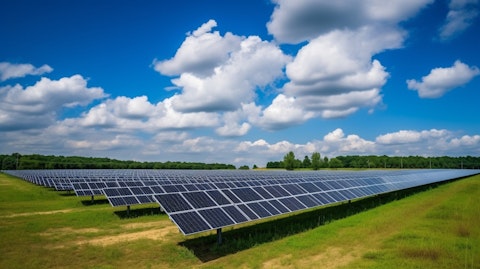
The increase in adjusted EBITDA was lower 1%, mainly due to lower production from our wind assets where we had a lower wind resource During the first nine months of the year. In South America, revenue increased about 14.5% compared with the first nine months of 2022 up to $140.3 million. And EBITDA increased 17.9% to $112.1 million. The increase was mainly due to assets which recently entered operation, inflation indexation mechanisms in our contracts, and a small gain corresponding to the sale of our equity interest in our development company to a partner in the first quarter. In the EMEA region, revenue and adjusted EBITDA decreased by 7.9% and 8.3%, respectively. This was mostly due to lower revenues at our solar assets in Spain, despite higher production during the period, mainly due to lower electricity prices compared with the same period last year.
As you’re aware of, these assets are regulated, and we’re entitled to re receive a predefined rate of return. The fluctuation in market prices do not affect the value of the asset. Production also decreased in Kaxu due to a scheduled major turbine overhaul, which took longer than expected, and a subsequent unscheduled outage. Looking below at the results by business sector, we can see similar effects. Let’s now please turn to slide number six, where our reviewer operational performance. Electricity produced by our renewable assets reach 4,383 gigawatt hours in the first nine months of 2023, an increase of 6% versus the same period of 2022, mainly due to the increase in our solar assets in the US and Spain, as well as the contribution from recently consolidated assets and those that have entered operation recently.
Looking at our availability-based contracts, in our efficient natural gas and heat segment, availability decreased mostly due to scheduled maintenance stops during the period, which did not impact revenue. Our water assets and transmission lines continued to achieve very high availability levels for the first nine months of 2023. Moving to slide number seven, we can see that during the last month, and given the current conditions in the capital markets, we have proactively managed our investments, and now we have investments commitments in 2023 in the range of $100 million to $120 million, and $150 million to $180 million in 2024. As you can see, we have moved certain investments from 2023 to 2024. Additionally, together with our partners, we are in the process of divesting our 30% stake in Monterey, the natural gas asset we owned in the north of Mexico.
If the transaction closed, the net proceeds of Atlantica would be in the range of $46 million to $53 million. We continue to have ample liquidity to finance the growth, with $48 million in cash at the corporate level and $393.1 million available under our revolving credit facility, which totals $441.1 million of corporate liquidity. I will now turn the call back to Santiago.
Santiago Seage: Thank you, Francisco. As I mentioned before, if we move to page eight, we do see a constructive PPA market in the key or the core PV wind storage technologies. We see clients who are ready to accept somewhat higher pricing and who are looking now for credible counterparties when they sign a contract. In that context, we share with you these two PPAs we have signed for our projects, Coso Batteries 1 and Coso Batteries 2. Both projects have been signed with an investment grade utility in California. These are tolling agreements with fixed payments and 15 years duration. We already covered Coso Batteries 1 in the past. Coso Batteries 2 is a similar storage projects, a project with 80-megawatt hours capacity offering four hours of storage.
It is also located within our Coso geothermal plant, and we expect to reach COD by 2025. Around the storage, we continue seeing a significant opportunity in a number of our markets, including California. And that’s why if we move to page nine where we can take a look at our development pipeline, we see there that a significant percentage of our pipeline is actually in storage projects. Worth mentioning as well, when we look at our pipeline, we are focusing on North America, and almost a quarter of the pipeline correspond to repowering and expansions of existing assets, as many of you know, investments that generally have higher returns. If you want to continue, Francisco.
Francisco Martinez-Davis: Okay. Let’s turn to slide number 10, please. As we mentioned in the introduction, given the recent volatility in the sector, we believe it is worth spending a couple of minutes reviewing our our financing model. This has been an integral part of our strategy and we have always followed the same principles. Our financing strategy is underpinned by one key principle, a majority of our financing is non-recourse, self-amortizing project debt in ring-fenced subsidiaries. Our assets repay their project debt progressively. As you can see on the graph on the left-hand side of this slide, the project debt of the existing portfolio will be reduced by $1.9 billion over the next five years. This graph also shows the repayment calendar.
This is not an objective. This is how our contracts are structured. The project debt for the current portfolio, which is $4.4 billion as of today, is expected to decrease to $2.5 billion at the end of 2028. If you look at the table below, you can see that our project debt service in the last two years. This gives you an idea of the cash available for distribution before project debt service, close to $860 million in 2022. The model is simple and transparent. We do not have any compact financings or partnerships where partners have preferred distribution rights. When it comes to corporate debt, we are committed to maintaining a balanced and sustainable capital structure. Our net corporate debt represents today approximately 20% of our net consolidated debt.
Our net corporate debt to CAFD available for distribution ratio is currently at 3.4 times. Our current leverage is lower than that of our peers, and this is reflected in our credit ratings of BB+ by both Standard & Poors, and Fitch. Looking at the interest rate risk, we have ensured that 93% of the consolidated debt has either fixed interest rate or is hedged. For the long-term project debt agreements, the interest rate is fixed, or we have hedges in place for the entire life of the financing agreements. Additionally, our first sizeable corporate debt maturity is mid-year 2025, and it amounts to $113 million. So, we don’t have to worry about step-ups in our financing costs due to refinancings in the short term. We believe that this prudent financing model is key to reduce refinancing and interest rate risk and to provide stability to the business.
With this, we conclude today’s presentation. Thank you very much for joining us. We will now open the line for questions. Operator, we’re ready for Q&A.
See also 10 Best Debt Free Penny Stocks to Invest In and 21 Largest Stock Exchanges in the World.
Q&A Session
Follow Atlantica Sustainable Infrastructure Plc (NASDAQ:AY)
Follow Atlantica Sustainable Infrastructure Plc (NASDAQ:AY)
Operator: Thank you. [Operator Instructions] Our first question today comes from Julien Dumoulin-Smith of Bank of America. Your line is open.
Julien Dumoulin-Smith: Hey, good morning, Santiago, and team. Pleasure to chat here. Just wanted to follow up on your comments at the outset here. You’re clearly sort of emphasizing your relative advantages versus your peers, if you will, on development activities. Just want to understand, is that a relative ramp that you’re talking to here that we should expect? I mean, obviously, Coso, well done, sort of obvious opportunity here in terms of being an incumbent, but should we expect more in that same vein here, or are you thinking that kind of the same level of consistent overall or perhaps capital oriented towards acquisitions and development is going to be sustained, or is this more of a pivot towards internal expansions of brownfield sites that you think are more tactful, if you will?
Santiago Seage: Thank you for the question, Julien, and good morning. So, our plan, as you know, over the last years, what we have been sharing with you, our intention in terms of investments is to deploy capital wherever we see the best opportunities. And that should include a combination of expansion/repowering of existing assets, together with development of new projects, in some cases capturing synergies with existing projects, like the two we described today. So, as you know, these projects are co-located within the geothermal plant. There are synergies in terms of land, in terms of connection, in terms of O&M, but these are two totally separate projects with two totally separate PPAs. And additionally, we plan to invest in other, let’s say, greenfield development projects within our pipeline, and whenever we find the right opportunities, acquisitions of projects in operation.
So, all of the above and ensuring that we allocate capital where we see the best opportunities.
Julien Dumoulin-Smith: Great. Excellent. But this isn’t a change in incremental allocation as far as you’re concerned. And more importantly, as you think about the strategic review, I mean, is this a sign on your side that you’re wanting to be even more involved as an independent developer here versus perhaps the ongoing and separate strategic process here? I just want to make sure I’m understanding the signaling right as far as your relative emphasis on the call today.
Santiago Seage: So, regarding the review, we are not signaling anything, Julien. And regarding the growth strategy, this is what we have been following for a number of years, which is a combination of investments in acquisitions and in projects, we develop greenfield or expansion of existing assets. So, from that point of view, no change in our strategy. We are perhaps reminding people that we do see opportunities in front of us, but no, we are not signaling any change there, Julien.
Julien Dumoulin-Smith: All right, excellent. And just to reiterate that last point finally, as you think about the strategic review and the process underway here, any thoughts about buyback here at all? I mean, just given the way the shares of moves of late, I just wanted just to ask you that directly here, if ever that was on the table. I mean, obviously the review itself might inhibit that, but I’m just curious if you have any thoughts about that, especially given your comments on organic.
Santiago Seage: Yes, the review does inhibit that. So, while going through an honesty review, that’s not an option in terms of investment.
Julien Dumoulin-Smith: All right, fair enough guys. Thank you very much.
Operator: Our next question comes from Mark Jarvi of CIBC Capital Markets. Please go ahead.
Mark Jarvi: Yes, good morning, everyone. Just in terms of the planned investments as you look out into 2024, how much of that would be, I guess, commercially secured full line of sight versus stuff that you still need to, I guess, find commercial agreements, PPAs, what have you to, to advance next year?
Santiago Seage: Good morning, Mark. Most of that as the commercial agreements required for the investment to happen, when we allocate capital or we commit an investment, it’s because we have been able to put the different pieces together. So, all or most of that is there.
